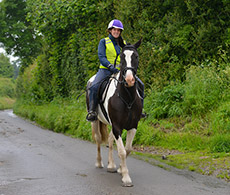
Schooling exercises to do while out hacking
Schooling your horse out on a hack will not only keep them keen and interested in their work, but also provide riders with an excuse to get out of the arena and enjoy the surrounding countryside.
A bit like going to the gym every day, riding in an arena can get tedious for both horse and rider, so working on schooling exercises and your horse's way of going while out hacking is a great alternative.
For those who don't have access to an arena, or whose arena or fields are flooded or frozen over winter, performing schooling exercises while out hacking will help to keep your horse fit, supple and happy through the colder months. Hacking out also exposes your horse to different terrain and surfaces, which is good for joint and soft tissue health.
If your horse is a bit fresh or more spooky in the winter, incorporating schooling exercises while out and about will help focus their mind and engage their body.
Here are some ways you can school while hacking your horse.
Warming up
Whether you are riding in the arena or schooling while out hacking, it's important to give your horse a period of warming up to ensure their joints and soft tissues are ready for work.
If safe to do so, allow your horse to start the hack by walking out in a relaxed manner with a loose contact so they can stretch their head and neck forward and down, and swing through their back. You can also gently bend the neck to the left and right to loosen both sides and flex at the poll.
After walking, let your horse go forwards into a free-moving trot (while being mindful of the surface you're on), and allow them to carry their head long and low. When trotting on a hack, remember to vary your trot diagonal to develop your horse's muscles equally.
Contact
Once your horse has warmed up, you can start asking them to work into a contact. Close your legs around the girth to ask them to move forwards and take a soft feel of their mouth with your hands, slowly taking up more contact on the reins.
When your horse accepts the contact, keep your hands steady and even, gently allowing your hands to move with the horse's movement. Encouraging your horse to go into a correct outline like this will develop the horse's topline, vital for strength and performance. It can, however, be tiring for horses, especially those that are young or unfit, so give them plenty of breaks.
Straight lines
It's actually quite challenging to ride a perfectly straight line, but practice makes perfect.
Long, quiet lanes and grass verges can offer the perfect opportunity for practising straight lines. Keep your horse straight using just your weight and leg aids, with equal weight and feel in hands, legs and seat. At first, horses will struggle to stay straight for long, but the more you practise, the easier they will find it. Keep checking in on your own position, as a crooked rider will create a crooked horse.
Transitions
Another exercise to practise on a hack is transitions. Transitions are great for teaching a horse to accept and respond to your leg, seat and hand. The aim is for your horse to be responsive to light aids, and it's a great way to keep their attention. You could walk for five strides, trot for 20, then walk for 10 and halt, changing up the order and number of strides as you progress. When halting, ensure your horse doesn't walk off again until you have made a clear aid.
In dressage particularly, accuracy is key, so when making transitions, use natural markers on your hack, such as telegraph poles, fence posts and trees to make your transitions at a precise moment.
Transitions within the pace
Once you have mastered basic transitions, you can then move onto transitions within the pace.
A safe, straight stretch of road for practising walk transitions, or along the hedge line of a field for trot and canter, are the ideal places to shorten and lengthen your horse's stride. As well as keeping your horse interested, this is great for improving general control.
You could pick two markers – such as trees or fence posts – and count the number of strides your horse takes in trot and canter between them. Then, the next time, lengthen or shorten the stride, thus decreasing or increasing the number of steps taken.
To shorten strides in walk, sit tall and still in the saddle and give a half-halt. If in trot, slow your rising and half-halt. To increase stride length, put your leg on and gently push with your seat, allowing with your hands to increase the stride length.
Shoulder-in
Shoulder-in is a great lateral work exercise that can help build your horse's suppleness, straightness and balance, and can really benefit your horse's whole way of going. Along a quiet stretch of road, try moving your horse into shoulder-in to both the left and right to really get them engaged.
When performing shoulder-in, your horse moves forward in a straight line, but is bent slightly around the rider’s leg, looking away from the direction they are travelling. To ask for shoulder-in, drop your weight down through your right hip and into your right leg to create a right bend with your body, then move your right seat bone forwards a fraction so your hip is slightly over your knee. The right hand asks the horse to flex to the right and the left hand asks the horse to wait. Try in the other direction using your left hand.
Turn on the forehand
A turn on the forehand is where the horse's front legs stay still but their hind legs move in an arc around them. This basic movement helps increase the suppleness in the hindquarters. While hacking your horse, it's likely you'll be able to practise this move when opening gates.
To ask for a turn on the forehand, hold the halt, bring the right leg back just behind the girth. Squeeze and press with your calf to ask your horse to move their hindquarters in an arc around their forehand. Try turning in both directions. If your horse does not already know how to do this, praise after just one step over and build it up from there.
Leg-yield
Leg-yield is about loosening your horse laterally and over their back, improving suppleness and relaxation. It can be a useful tool to help re-centre your horse's mind and body if they're spooking at something.
To ask for leg yield, put your right leg on the girth, half-halt using the left rein and use the right rein for flexion. As you ask for the step away from your right leg, your horse should stay straight through their body with a slight flexion at their poll, away from the direction of travel. The hind legs should step under and across as they move forward and sideways in a relaxed manner. Now try in the opposite direction.
Final tips
Remember that safety takes priority when hacking a horse, so ensure you have adequate control and road safety knowledge before you set off. It's also worth considering teaching these movements in the safety of the arena first and then practising them out hacking once established.
Found this article useful? Want to see more similar content and engage with like-minded horse owners? Follow us on Petplan Equine’s Facebook page.
Do you think we’re doing a good job? If you do, please vote for us in this year’s Insurance Choice Awards. Plus, you’ll also be entered into a prize draw to win £1,000 (Ts&Cs apply)




